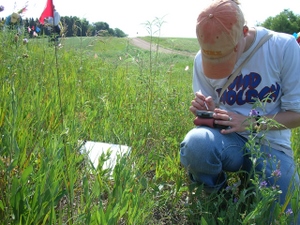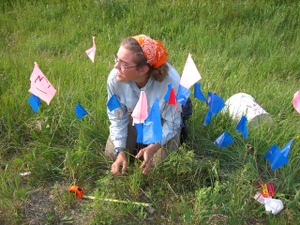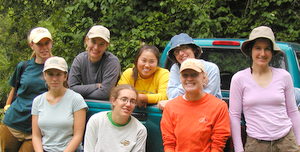We are no longer accepting applications for this position.
Please read about our current opportunities!
Are you interested in gaining field research experience and learning about the ecology and evolution of plants in fragmented prairie habitat? If you are, then this might be the opportunity you are looking for!
The Echinacea Project is looking for interested and enthusiastic summer field researchers for the 2012 summer field season. Our project investigates how small population size and reduced genetic diversity influence individual fitness, population demographics, plant-insect interactions and evolution in the purple coneflower Echinacea angustifolia. This is a great internship or summer co-op for aspiring ecologists, conservation biologists, and evolutionary biologists!
Qualifications: College student or recent graduate, wants to work outdoors, is patient, has good hand-eye coordination and fine motor skill, willing to work hard even in inclement or hot conditions, and interested in ecological research. No experience is necessary, but you must be enthusiastic and hard-working. Several spots are reserved for current undergraduate students interested in conducting their own research project–see details below.
Dates: The main field season runs from mid-June to the last half of August. We may hire one person to start in May to help with a seedling recruitment experiment. The exact start and end dates are negotiable.
Money: There is a $440/week stipend and housing is supplied.
Job Description
The main research project is to determine evolutionary and ecological consequences of habitat fragmentation on purple coneflower, a beautiful and relatively common prairie flower. The research site is in western Minnesota. Stuart Wagenius is the field supervisor.
The narrow-leaved purple coneflower, Echinacea angustifolia, grows in the former tallgrass prairie and plains of North America, a habitat now fragmented by human activities such as agriculture, development, and roads. Echinacea now exists in isolated populations of various size. We know that seed production in isolated plants is limited by pollination and that genetic diversity is lower in small populations compared to large populations. We still don’t know the long-term consequences of reduced seed set, low-fitness seedlings, and reduced genetic diversity on the persistence of these populations.
During this summer, we will systematically map over 2000 plants in natural populations that have been observed for the past fourteen years to compare the fecundity and mortality of plants in small and large populations. For another ongoing project, we will measure growth, flowering, and fitness traits of plants growing in research plots. The goal of this project is to estimate the genetic and environmental influences on Echinacea plants originating from small and large remnant populations. In addition to measuring plants and collecting data, we will maintain plots by mowing and weeding.
You will gain skills in identifying plants, surveying natural plant populations, measuring plant traits in experimental plots, hand-pollinating plants, and observing & collecting insects. You will learn many techniques for experimental field work in plant ecology, genetics, and plant-insect interactions. Specific skills you may gain include collecting seed, surveying and GPS techniques, artificially pollinating flowers, identifying insects, mapping plants, characterizing communities, gaining appreciation for long-term experiments, and working as part of a team.
Independent project: If you are interested, you will have the opportunity to work on an independent research project on your own or in a group. Projects can explore questions about the ecology and evolutionary biology of Echinacea angustifolia, another prairie plant species, or plant associated insects. All work occurs in the context of prairie remnants which allows projects to be directly applicable to conservation challenges of habitat fragmentation. Here are some examples of past projects: “Insect diversity in prairie remnants,” “The effect of remnant size on the diversity of Echinacea-visiting ant species,” “Effect of inbreeding on symmetry of floral display,” and “Competition between Echinacea and thistles for pollinators.”
Living: The study area is a rural agricultural community. The closest towns are Kensington (56343) and Hoffman (56339), MN. Alexandria, a larger town with a movie theater, is 20 miles away. In Solem township there are dirt roads, a highway, railroad tracks, wetlands, and lots of corn and soybeans. There are prairie remnants scattered throughout the township. You’ll live in a house with basic amenities and basketball hoop. You’ll share the common area with other team members, but you’ll have your own space and a bed. Usually we’ll eat lunch together at our base station.
REU Program Details
Every year we reserve several spots on the team for undergraduate students interested in conducting an independent research project. The Echinacea Project offers a great opportunity for independent field research projects and the REU opportunity is excellent for aspiring ecologists, conservation biologists, and evolutionary biologists! In addition to housing and stipend, travel expenses to the research site will be covered. Start and end dates are flexible.
To apply for this opportunity please follow the general application procedure and indicate your interest and eligibility in the REU program. During the summer, an REU participant must be enrolled in an undergraduate institution and be a US citizen or permanent resident of the US or its possessions. Members of underrepresented groups are particularly encouraged to apply.
To increase your chances of working on the Echincaea Project as an REU, you should also apply to the REU program at the Chicago Botanic Garden…
CBG program details
This research opportunity involves 2 weeks at the Chicago Botanic Garden (CBG) and 8 weeks at the field site in Minnesota. You will start at CBG on June 11th and learn about techniques in field botany and design your independent project in consultation with Stuart. Then you will conduct field work in Minnesota and work with the Echinacea Project team. In August you will return to CBG to present your poster.
In addition to the stipend and housing, travel and some food expenses are provided.
To apply, visit the CBG REU website and follow the directions. Due date: 31 January 2012. Be sure to select a project mentored by Wagenius as a top choice, like this one or this one!
To be eligible for the CBG REU position you must be enrolled in an undergraduate institution and be a US citizen or permanent resident of the US or its possessions during the summer. Members of underrepresented groups are particularly encouraged to apply.
How to apply
Ask yourself if you love being outdoors, if you are patient, if you can work independently, if you are willing to work hard in adverse conditions, and if you could be enthusiastic about this job. If you answer yes to these questions and you still want the job, please apply. Your application should include:
- a cover letter, including the following…
- why you’re interested
- what your future plans are
- when you can start and end
- whether you are interested in an independent project
- if you’re interested and eligible for an REU
- who will serve as your references
- your email and phone number
- your resume
- your transcript (unofficial OK)
- one letter of recommendation (sent by recommender)
Send your application via email to echinaceaProject@gmail.com by 29 February 2012.
Review of applications will begin on 29 February 2012. We’ll accept applications until positions are filled. Be sure to include an email address and phone number where you can be reached during March.
Members of groups underrepresented in science are particularly encouraged to apply.
More information
If you have any questions, contact Stuart via e-mail or phone (847-835-6978).
Go to the Echinacea Project’s homepage to read more about this NSF-funded project. You can also read about this project’s background and papers.
Photos of recent summer field researchers
Here’s a brief field equipment list from 2004.





